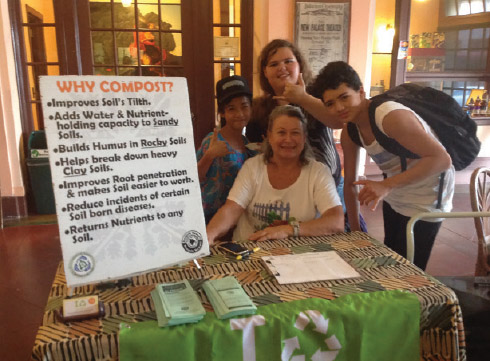
Composting At Home: Treasure in the Trash
By Barbara Fahs

One autumn day in 1971, a young woman was busily building a compost pile alongside her new home. Two little girls, eight and nine, wandered by and asked what she was doing. “Well, I’m making a place to dump my food scraps and all the leaves I rake up and other stuff,” the woman replied. Fascinated by this new concept, the girls hung around for a while, helped out where they could, and ended up having cookies and milk with the woman.
Making new friends is just one of the benefits of composting. Another benefit is how easy it is to make free fertilizer from things we often consider rubbish.
When you don’t put your leftover food into the trashcan, undesirable creatures like flies and ants won’t become residents in your home.
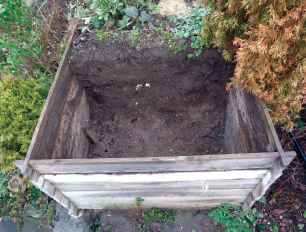
Using waste food has become mandatory, with the cities Seattle and San Francisco enacting laws requiring composting. (See SFenvironment and CNN links at the end.)
And of course, your plants will thrive. Whether you use your finished compost around an avocado tree, a tomato plant, or a hibiscus shrub, the health of your plants and the quality of their flowers or fruit will quickly become evident.
Composting at home is as easy as laying plant and food materials on the ground. Or you can get a bit more fancy. However you choose to create your compost, all of the various methods are simple. Let’s get started!
A Bit of History
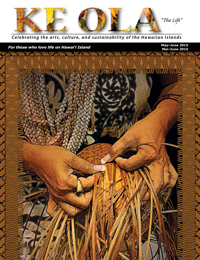
Modern-day fertilizer companies weren’t around when great-grandma and grandpa ran their farm or grew a victory garden. Since ancient Mesopotamia, over 2000 years BC, people have created compost to nourish their plants. Until the 20th century, composting remained the standard method of farming. At that time, synthetic fertilizers began to appear on the market; many farmers switched to them and abandoned composting.
In the 1970s, Australians Bill Mollison and David Holmgren developed a method they dubbed permaculture, or “permanent agriculture.” As Mollison explains in his book, Introduction to Permaculture, “Permaculture is a design system for creating sustainable human environments.”
Things really took off in 1972, when the group Ecology Action started a half-acre vegetable garden experiment in Palo Alto, California. They used the French intensive biodynamic method to create deep, rich growing beds that supported more plants than traditional methods. They produced a garden that provided a complete vegetarian diet for one person on only 2,800 square-feet of land. This method has been introduced to many countries, where it has helped to overcome poor soils, droughts, and famines.
Easy Composting Methods
Making compost is an easy process. Here are several simple methods.
Do It On the Ground
Start your compost pile by spreading a layer of broken up twigs, seedy weeds, and other seemingly useless stuff on the ground, in an area about four feet by four feet. If you want, build a frame from two-by-fours and chicken wire or simply stand four wooden palettes on end and lash them together.
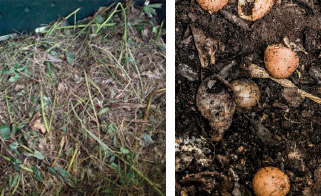
Then start adding organic materials. Grass clippings and raked-up leaves are perfect. Add food scraps if you have any, and also wood ashes, straw, or whatever you have lying around. Alternate layers with fresh, green, leafy materials (which give it nitrogen) and dried, brown materials, such as fallen leaves (these provide carbon).
Cover your pile with black plastic to keep critters out and prevent your pile from becoming too wet due to rain. Add food scraps when you have them, burying them to prevent animals and insects from enjoying the feast.
Two methods of composting exist: active and passive. With the active method, you turn your compost pile every few weeks to speed up decomposition. With the passive method, you just let it sit. Decomposition will still happen, but your finished compost will take longer if you don’t turn the pile.
Hack, Whack, and Stack
Fruit trees and ornamentals benefit from occasional pruning. Whenever you “hack” off a branch, simply stack it around the base of the same tree. “Whack” it up into shorter lengths if it’s unwieldy. This method will nourish your plant and help to smother weeds that might want to grow around it.
Sheet Composting
This permaculture technique has been popularized in the book, Lasagna Gardening. It allows you to create a garden space in less than one day. Start by covering an area with flattened cardboard or layers of newspaper. Don’t worry: today’s inks are soy-based. Then stack alternating layers of organic materials on top, as we described above. Water it well and plant right away.
Purchased Bins
Purchased compost bins are attractive and work well in small yards and suburban neighborhoods. Some include low doors, which allow you to scoop out finished compost from the bottom of the heap while fresher food scraps and other materials decompose on top.
“Laulau” Method
Kona coffee farmer Una Greenaway of Kuaiwi Farm has come up with a cool and easy way to compost right where you pull the weeds and trim dying leaves off of your veggies or flowers. She calls it the “laulau” method because all you do is roll up your materials in shade cloth or other porous materials and lay them next to the plants.
The Chicken Method
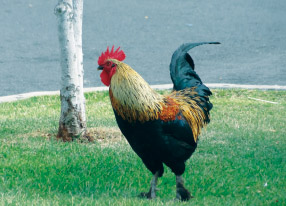
Chickens provide a great way to dispose of food scraps and other organic materials such as raked leaves and grass clippings. Simply dump your refuse into their coop. What they don’t eat, such as citrus and liliko‘i rinds, decomposes. As they walk around, they will fertilize it further. Every couple of months, rake out the coop and add what you gather to your compost pile, which will allow fresh chicken manure to mellow before you use it on any plants and possibly burn them.
Wonderful Worms
Worm composting is the perfect answer if you live in a smaller place with little outdoor space. It’s clean, compact, and odor-free. Make a simple system with plastic storage bins that you keep under your sink or on your lanai. Don’t worry—they won’t escape from the bin!
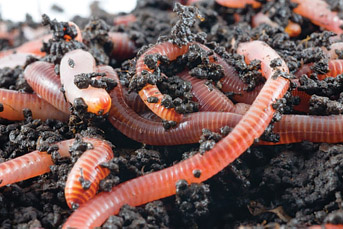
Purchase three plastic storage bins, about seven inches by 12. Drill 1/8-inch holes in the bottoms of two of them and then stack the bins on top of each other, with the undrilled bin on the bottom. Cover the top one and save the other two lids.
In the top bin, add damp strips of newspaper, filling about half full. Add chopped up food scraps and your worms to this bin. Avoid meat, oils, dairy products, cooked food, citrus fruit, onions, and broccoli. Favor a variety of fresh vegetable matter, such as papaya rinds and wilted lettuce. Keep your worm bin in a shady spot.
After about three months, move the top bin to the center position and put damp newspaper strips and food into the new top bin. The worms will crawl through the holes in the bottom of the top bin to get to their food and in two to four weeks the contents of the middle bin will be ready to use as fertilizer. Mix it with soil or water. Use the liquid in the bottom bin directly on plants.
Just one point: it is illegal to import worms from the mainland, so look for approved red wigglers (Eisenia fetida), which are a Hawaiian variety.
Using Your Finished Compost
Several easy uses exist for finished compost:
- Mulch is a common use of your finished compost. Just shovel it on top of the soil around any type of plant.
- When you create a new garden bed, dig compost into the soil before planting.
- Make compost tea by mixing half a bucket full of compost with water and letting it steep overnight. Then water your plants with it. Simple as soup! Use the remaining compost in your bucket as mulch.
Dos and Don’ts
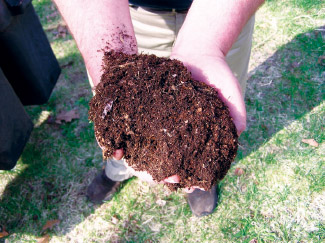
Examples of materials you can add to your compost pile:
- All fruit and vegetable matter, including seeds
- Ashes from wood fires
- Boxboard, such as pizza and cereal boxes, torn up
- Coffee grounds and filters
- Dryer lint
- Egg and nut shells
- Farm animal manure
- Grass clippings and disease-free plants
- Nail clippings and hair
- Rice and pasta
- Shredded paper and newspaper
- Tea bags (remove the staples)
- Used paper napkins, toilet paper rolls, and paper towel rolls
- Weeds before they form seeds
The list of items that you should not include in your compost pile is shorter:
- Ashes from barbecue charcoal
- Cooking oil
- Dairy products
- Glossy paper, such as magazines and newspaper inserts
- Meat, fat, bones, and fish
- Pet and human feces
Composting Classes
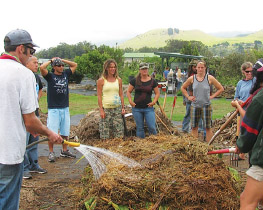
Ann Hassler of Hawaii Rainbow Worms says her composting classes ended, due to loss of funding. Through Hawaii Rainbow Worms website, she is still offering fee based workshops to schools and civic groups. “I’d also be glad to teach independently if there were a call for it.”
Remember the woman from the beginning of this article? That was me. The two little girls are now 52 and 53 years old and remain two of the best friends I have had in my life. All because of composting. ❖
Contact Ann Hassler: Crazy4compost2@gmail.com, facebook.com/Crazy4Compost
Contact Hawaii Rainbow Worms.
Contact writer Barbara Fahs.
More Info:
How To Grow More Vegetables. John Jeavons. Ten Speed Press, 1974.
Lasagna Gardening. Patricia Lanza. Rodale Press, Inc., 1998.
Super Simple Guide to Creating Hawaiian Gardens. Barbara Fahs. Authorhouse, 2006.
Carryoncomposting.com/142941469
cnn.com/2014/09/24/politics/seattle-composting-law/
Compost.css.cornell.edu/worms/basics.html#Materials
Nytimes.com/2015/03/04/dining/efficiency-in-the-kitchen-to-reduce-food-waste.html?emc=edit_th_20150304&nl=todaysheadlines&nlid=50844754&_r=1
Science.jrank.org/pages/1671/Composting-History.html
SFenvironment.org/article/recycling-and-composting/mandatory-recycling-and-composting-ordinance
Web.extension.illinois.edu/homecompost/history.cfm
Creativecommons.org/licenses/by/2.0
Creativecommons.org/licenses/by-sa/3.0


